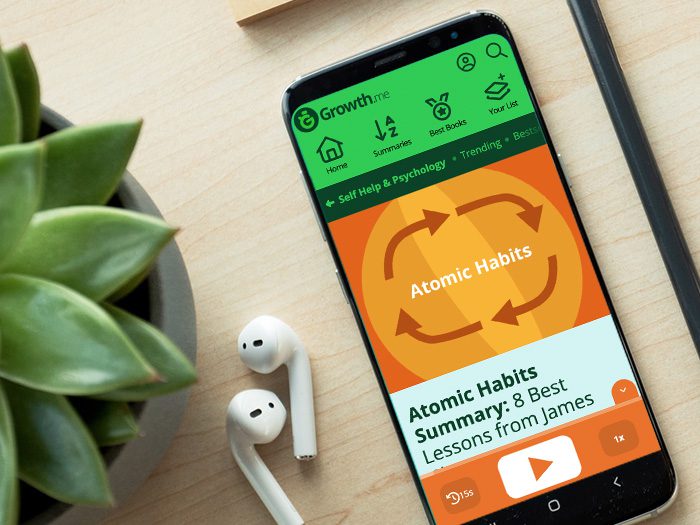If you’re a business owner, then you probably want two things: growth and control. I mean, what entrepreneur doesn’t want that? Reaching the next level, while avoiding frustration.
This book Traction may just have the key to helping you achieve those goals. It has a buffet of cool tools that can improve the internal processes in your business. The author Gino Wickman readily admits that most of the ideas in this book are not original. He was taught and inspired by other influential business thinkers like Verne Harnish, Patrick Lencioni, and Jim Collins. (Here’s a nice overview of Good to Great, the most popular book by Jim Collins.)
But what makes this book popular is how it packages all the ideas together so nicely—into what he calls an ‘operating system’ for entrepreneurs. Each chapter is like one piece of a jigsaw puzzle, that come together to make one beautiful picture.
Who is Gino Wickman?
Gino Wickman (official site) turned around his family business, which was related to real estate sales training. Then he began helping other entrepreneurs to gain traction and control, too. 20 years later, his books have sold over 1 million copies, and his average client increases their annual revenue by 18%!
🔮 1. Define Your Vision: Start with an exciting 10-year vision, then work backwards to decide everyone’s weekly action steps
What’s your big exciting dream? That’s the starting point of getting traction in your business. And it’s not a bad way to start, I think!
The first tool in Traction is a 2-page vision about what your company will look like in the future, and how you’ll get there. This is basically a very high-level business plan, to make sure you know where you are going before applying the other tools. It’s also important to communicate this plan to the whole company and have everyone refresh their memory of it every quarter.
Your written vision includes:
- Your company values. First write down why your company exists, besides making money. Then come up with 3-5 central values, that you will use to measure all new and existing employees.
- Your company goals. Start with huge 10-year dream that is exciting to all, then break it down to 3-year goals, then 1-year goals, then 90-day goals. What does your company need to achieve in the next 90 days, to stay on track with the longer-term goals?
Personally, this was one of my favourite parts of the book—the idea of ‘planning backwards’ from an exciting future vision to goals that are weekly, bite-sized, and achievable.
- Your marketing strategy. This includes what segment of the market you serve and what makes you unique. For example, in Wickman’s family real estate business, a turning point in their success was narrowing their target market down to a list of 500 specific executives. Then part of your uniqueness comes from creating a diagram of ‘the proven process’ you use to deliver your product or service, which is usually very effective in sales presentations.
One common criticism that I read about Traction is that it neglects marketing and sales. Like it does not talk much about studying your customers or competitors. So if you are just starting a business or your primary goal is to get more sales, then you’ll need to read a different book like Blue Ocean Strategy. This one is more focused on businesses systems and organization.
Many online reviewers of Traction believe this book builds upon another classic book for entrepreneurs called The E-Myth Revisited by Michael Gerber. The E-Myth was all about building a business that works without you, the business owner, so that you can achieve true success and freedom. How? It recommends working not just IN your business delivering your product or service, but also ON your business, to create a structure that is truly organized.
But even in the E-Myth, the first step for an entrepreneur is to begin with your Strategic Objective, which is “a very clear statement of what your business has to ultimately do” so it can help you achieve your most important goals. Basically it always comes back to the classic self-help advice (from Stephen Covey) to “Begin with the end in mind.”
Read more in The E-Myth Revisited by Michael Gerber
Traction begins with a 2-page business plan. First, write down the reason why your company exists, and the 5 essential values everyone should strive for. Second, write down a 10-year vision, then break it down to goals for the next 3-years, 1-year, and 90 days. Third, come up with a marketing strategy that includes your specific target customer and 3 ways what you do is unique like a ‘proven process.’
👥 2. Build Your Team: Hire people that fit your company values, then keep them performing well with accountability
One of the biggest challenges in growing a business is hiring the right people and keeping them productive. Traction’s approach to people can be summed up as “the right people in the right seats.” This catchy phrase is borrowed from the influential business author Jim Collins.
- The right people means finding team members who are also excited about your company’s long-term vision because they share the central values of your organization. To find out whether someone is the right person, Gino Wickman recommends analyzing all your people with a chart. Write down all your people’s names on the left side of the chart, then all your company values across the top, and use this chart to grade how well each person matches all your values.
- The right seats means someone is good at their job, likes doing it, and knows what they’re accountable for. Wickman recommends drawing a classic organizational diagram, which looks like boxes connected with lines. Begin with boxes for your company’s major functions—like marketing, accounting, product development, etc. Then make sure only one person’s name is in each of the boxes, because that is what creates the accountability.
Amazon.com is one of the largest companies of our time, and it made the founder Jeffrey Bezos into the richest person in the world. But let’s not forget that when the website was started in a little Seattle garage in 1995, there were just 3 workers. Bezos was running the company, his wife Mackenzie was doing the finances, and a programmer named Shel Kaphan was coding the website. Anyone in the office may have shipped the latest order. In those days their organizational diagram would have had 3 boxes!
But Amazon grew quickly, which meant each box had to split into several boxes. They moved into a larger office, rented their own warehouse, and hired managers and specialized workers. According to Traction, this is the journey that all growing companies must follow. From the early days when the founder is doing a little bit of everything, to a mature company with a clear division of who is responsible for what.
Read more in our summary of The Everything Store by Brad Stone
“The right people in the right seats.” Get the right people by making a chart that grades how well each person matches your company’s values. Get them in the right seat by making sure they’re good at what they do, and like doing it. Draw a diagram of your organization, making sure that one person is accountable for each function.
📊 3. Use Data for Decision-Making: Use a weekly data dashboard for clear insights; guide your business with facts
A data dashboard that lets you see all of your most important numbers every week is the best way to spot problems fast and make sure you’re heading in the right direction. Numbers will tell you the truth without ego, drama, or personal opinion.
So make sure you have one of these dashboards for your business, with one person assigned to update it weekly. One manager should be ultimately responsible for each number. Each business will have different important metrics, but some common numbers include: new leads, new sales, scheduled appointments, expenses, etc.
Every single person in your company should also have one number they are personally accountable for, a number that is concrete and measurable.
Having one primary number to judge their performance by, is what allows your people to know if they are providing the right type of value to the organization. For example, a salesperson could have a certain minimum number of weekly calls they need to make. Having a number puts a positive pressure on each salesperson to keep moving forward.
(However, this idea was frequently criticized in online reviews. Many said that ‘everyone having a personal number’ would cause people them to work to reach their number, but often at the cost of the overall business direction. For example, a salesperson may be able to contribute more to the company’s success this week by training a new employee or improving the marketing funnel, not by making more sales calls.)
A popular recent book for new entrepreneurs is called The Millionaire Fastlane by MJ DeMarco. After a few failed business attempts, he became wealthy by launching a limousine rental website, coming up with the idea while working as a limousine driver.
One of my very favorite ideas from DeMarco is that a truly successful business is not an event, but a process. You see, popular culture often shows us the message that most people get rich from one-day events, like buying the right stock one time or a lottery ticket. But in reality, most successful entrepreneurs do it through process, it takes time to build each part of a functioning business. We can pay more attention to process by looking more at our numbers and making a daily effort to move them in the right direction, until we hit traction.
Create a dashboard of your most important business numbers, then make sure someone updates this data every week. There’s no better way to keep an eye on your business’s health and direction. Then consider making each person in your organization accountable for one number, that is specific and measurable.
🚧 4. Address Issues Proactively: Tackle problems directly for a smoother path to your goals; promote transparency
Another major component of the business ‘operating system’ described in Traction are lists of issues. These are lists of the problems your organization must overcome to achieve its goals and vision. There are 3 types of issues lists: one in your main business plan, one for your leadership team, and one created by each department. Most of these lists should be updated weekly.
To solve the issues on the lists, at a weekly meeting your team must:
- Find the root cause of the issue, beyond the most visible symptoms. Getting to the root cause is important because it solves future issues at the same time.
For example, if salespeople are not following up with leads often enough, the root cause may not be that your salespeople are not motivated enough. It may be that your company doesn’t have a central application to organize all your sales activities. - Avoid tangents while discussing the issue, because getting off track is the main cause of inefficient meetings. Stay focused and if a related issue comes up, write it down so you can discuss it another time.
- Assign one person with a to-do item due at the next meeting. When the next step towards solving the issue has been agreed upon, then one person must be given accountability for accomplishing that step.
Reaching your company goals and vision will mean you encounter obstacles. These can be systematically overcome by creating issues lists at leadership meetings. The lists should get to the root cause, the discussion should avoid tangents, and in the end one person will leave with a 7-day to-do item.
✅ 5. Standardize Processes: Document essential processes for efficiency and scalability; making operations smoother
Maybe the biggest difference between small businesses and fast-growing businesses is a focus on systems and repeated processes. By creating business systems, you simplify your life, train new people easier, and—most importantly—begin to optimize your systems. Optimization is so critical to being competitive in business.
When you get everyone to do the work one way, then you can continuously improve every step of that way. But no regular process, no optimization!
As a teenager, my first part-time job was in McDonald’s and I can tell you they had a process for absolutely everything. Right down to the order that pickles and onions should be put on a hamburger! Ray Kroc is the guy who grew McDonalds into a worldwide franchise and he said, “You must perfect every fundamental of your business if you expect it to perform well.” And now it all makes sense!
It’s all about writing down your current major systems:
- Decide what the most important systems are with your leadership team.
- Write the basic steps of each system, with a few bullet points underneath each step.
- Put it together into a document titled “Your Company’s Way.” Diagrams or Illustrations for each process can be very useful to communicate them better to everyone.
(I think here Wickman was inspired by philosophies like “The Toyota Way,” (Wikipedia) which was an analysis of Toyota’s unique approach to manufacturing.)
Traction often mentions another popular business author named Verne Harnish, who is also a big advocate of creating repeated processes to grow a business faster. In his book Scaling Up, Harnish wrote “Routines set you free” and “Goals without routines are wishes; routines without goals are aimless. The most successful business leaders have a clear vision and the disciplines (routines) to make it a reality.”
For example, a goal of getting into good physical shape is just a wish, unless we also have a fitness routine to make it happen. We need those personal routines and company processes to have a chance of accomplishing anything with a good probability of consistent success.
Learn more in Scaling Up by Verne Harnish
If you want to overcome the ceiling of a small business that depends on you, the owner, then you must focus on systems, processes, and repeated routines. First, decide on the most important processes, then for each process write down the steps one must follow, and finally create a document of all your process that can be shared named “Your Company’s Way.”
🤝 6. Foster Collaboration: Schedule regular meetings so everyone stays accountable, focused and aligned; prioritize and solve problems together
Organizations are made up of people doing things. (That is probably the most obvious sentence that I’ve ever written—but it’s true!) So the final component of Traction is all about how to organize the activities of your people, so they’re doing the right things at the right time.
I think this last part of the book can be summed up in 2 points:
- Set your important 90-day priorities. These priorities are nicknamed “Rocks” in the book, but the main thing is that everybody knows what the most important goals are for the next quarter, or 90 days. These priorities should be set at quarterly meetings for your whole organization. Individual departments and each individual should also set their own smaller 90-day priorities.
- Meet at regular, scheduled intervals. It’s fashionable to view meetings as a waste of time, but Gino Wickman says meetings bring focus and regular accountability, which may feel uncomfortable to some people at first. Important meetings include: An annual state-of-the-company meeting to update the business vision/plan, a quarterly leadership meeting to set 90-day priorities according to the vision, and many smaller weekly meetings to make sure everyone is on the right track.
Organizing the activities of your people comes down to setting goals and keeping everyone accountable. That means setting 90-day priorities called “Rocks” for your organization, departments, and individuals. Then creating meeting ‘rhythms’: annal for the entire company, quarterly for leadership, weekly for everyone.
- ‘Plan backwards’ with just one of your dream goals. For example, if you have a 10-year goal of reaching $1 million in sales, how much would you need in 3 years to reach that goal? How about 1 year? How about 90 days? What would you need to do in the next week to be on track for that goal? It can feel incredibly exciting to realize that our most ambitious goals can usually be broken down into bite-sized targets!
I would also add that your short-term goals don’t need to be extremely ambitious. As the productivity expert James Clear explains in his excellent book Atomic Habits, our daily habits are like compound interest. Our actions don’t seem to make much difference today, but over time those actions tend to build on top of each other, until we have an incredible result. It’s just like money that is invested for 10, 20 or 30 years—it can compound in value, but only if we are patient. - Create a list of 5 values that your company will stand for. To get you started, heres a list of 200 core values from ScottJeffrey.com. Usually, the best way is to brainstorm a long list of values, then cross out the ones you feel weakest about, until you’re left with a list of 5. Traction also recommends looking at your best employees, asking what makes them the best, then writing those qualities down so you can find or develop more people like that!
- Update a weekly spreadsheet with (at least) 5 of your most important numbers. These can include the number of: visitors, leads, sales calls, appointments, sales, repeat customers, etc. This is like a doctor measuring the pulse of a hospital patient. If you can’t see your numbers easily, then you don’t know the health of your business! Personally, I like using Google Sheets so I can see and update the business dashboard from anywhere.




















Community Notes